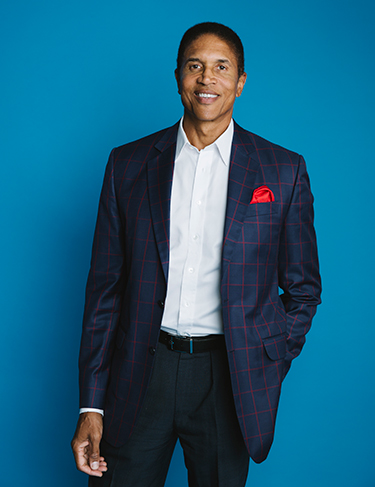
The Builder
Christopher J. Williams T'84 harnessed his architectural and business skills to grow the Williams Capital Group into one of the most successful mid-sized investment banks in the world.
By Kirk Kardashian
Mar 22, 2018

Christopher J. Williams T’84 is the founder, chairman, and CEO of the Williams Capital Group and Williams Capital Management, one of the most active co-managers of U.S. investment-grade new issue debt financings.
C
hristopher J. Williams T’84 is the founder, chairman, and CEO of the Williams Capital Group and Williams Capital Management, one of the most active co-managers of U.S. investment-grade new issue debt financings. In 2002, Williams was selected by Fortune as one of the 50 most powerful African Americans in Corporate America. Crain’s New York Business, in 2003, listed him as one of the top 100 minority business leaders. Williams has also been the subject of numerous articles on management in both The Wall Street Journal and The New York Times. What most people don’t know about Williams is that, at heart, he’s a gifted artist and designer who can bring a sense of craftsmanship to a profession known more by its numbers than its creativity.
Williams was raised in New Milford, Connecticut, a rural town on the western side of the state. He grew up in a modest single-family home on 40 acres and enjoyed hiking, trail-biking, and camping on the surrounding terrain. There was a stream that ran through his family’s property, and he would spend hours playing in it, catching fish and frogs, and sometimes just observing how the water changed from day to day. As he kept observing, he began drawing what he saw. He discovered he could re-create on paper, with technical precision, the trees and rocks and other elements of the landscape, but he also knew early on that some of his classmates were better artists—they could draw anything beautifully. Williams was more limited to angular things, so he thought architecture would be a good fit. He took an architecture course in high school, and then pursued that subject at Howard University.
After college, Williams was hired by the Architects Environmental Collaborative, an architecture firm in New Haven, Connecticut, and that’s where he found one of the keys to his later financial success. As he worked with the more senior architects and their clients, he discerned “a certain sequential thought process one follows in architecture, and it’s true of virtually any profession,” he says. “It’s the process of listening to what a client wants, accounting for the many constraints (budgetary, regulatory, topographical, engineering), and then going back and forth with a client to come up with something they will love.”
He uses the same process today when he meets with large corporations who want to discuss financing options. “Every time we meet with clients, they have unique objectives,” he says. “In capital markets, the goal is to structure the transaction in the manner that provides the lowest possible cost of financing by generating the greatest possible demand among investors.” There are cheaper structures that have additional risks (such as the risk of rising interest rates). There are different markets that attract specific investors. There’s a wide range of financing tools that come with varying degrees of flexibility. “Just as in architecture we have all these constraints that must be taken into account when designing a building,” Williams explains, “in finance I find a creative approach is also important.”
Just as in architecture we have all these constraints that must be taken into account when designing a building. In finance I find a creative approach is also important."
Williams ended up in the finance industry because he didn’t have great timing for a career in architecture. While working as an architect, interest rates remained extremely high and construction projects began drying up. Williams looked around. Firms in the northeast were reducing their staff sizes. He was at the bottom of the hierarchy. After talking to some friends and associates, he decided to apply to business schools. “I knew very little about what I wanted to do, other than obtaining a broader set of skills beyond the ability to design,” he says.
When Williams first visited Tuck, it was mostly just to take a look. He didn’t think it would be a good fit for him. But the school and its setting charmed him. He immediately felt the warmth and cohesion among the student body. He saw that the level of interaction between the students and the faculty, during the few days he was there, was deeper than what he saw when he visited other schools that were larger and located in cities. “As a student, it felt very good to be part of that type of community,” he recalls. “Very quickly, I felt at home and met people who ended up being good and lasting friends.”
Many of those friendships took root in his first-year study group, which Williams formed with fellow T’84s James Bradley, Michael Goulder, Wilbur Kim, Robert Wallace, and sometimes Peter Grieve as an honorary member (although he was in a another study group). Other friendships—with Robin Arnold, Kimberly Borden, and Sabina Wu Lusardi—were built at the occasional meetings of the wine tasting club. Some of Williams’s T’84 classmates also ended up becoming business associates: Edward Wiese, Caleb Aldrich, Nancy Corsiglia, Peter Grieve, Errol Harris, Colin Kerwin, and Williams’s first-year roommate, David Plants. Wiese remembers meeting Williams at a Tuck ’Tails event early in their first year. “He’s tall like a basketball player, and very striking when you first meet him,” he says. “He’s always got a smile and a glimmer in his eye, and a very positive attitude. From the day I met him he was cheerful, friendly and outgoing, and he continues to be that way.”
Bradley, a professor of operations management and business analytics at the College of William and Mary, immediately liked Williams because he was “down to earth and very easy to get along with,” Bradley says. And Williams happened to be the perfect study group partner because of his patience and open-mindedness. “He respects you and is willing to listen to and seriously consider your point of view,” he says. “He has opinions, but he’s not someone who has made up their mind about everything and is just going to do it. There’s give and take, honest exchange.”
Wallace, the president and CEO of BITHGROUP Technologies, a systems engineering consulting firm, has similar memories of Williams. “When we had Tuck ’Tails, Chris was like a magnet. People were naturally drawn to him because he was sincere, blessed with an infectious personality, and just fun to be around,” he says.
As fellow African Americans in a mostly white community, Wallace and Williams naturally gravitated to each other. But they had other things in common, too. They both had backgrounds in the physical sciences (Wallace has a degree in mechanical engineering and applied mechanics from the University of Pennsylvania), and they shared a love of basketball and tennis. Their friendship deepened in their second year when Wallace, who had two children and a third on the way, became severely ill and couldn’t attend class. He hadn’t secured a job yet and was worried about providing for his growing family. “Chris is one of the main reasons I was able to manage my way through that time,” Wallace recounts. “Chris encouraged me. He would bring me the course work we had to do. He would keep me abreast of what was happening in our classes. He was a friend, and one of the anchors that kept me stable during that time.”

Wilbur Kim, a managing director at Cambridge Associates, got to know Williams as a thoughtful, analytical person with a quiet demeanor. But that impression was complicated a bit after Kim visited Williams at his apartment in the Village, in Manhattan, during the summer between their first and second years. Williams had an internship at Morgan Guaranty Trust (now J.P. Morgan), and it was his first time living the high-energy Wall Street lifestyle. Kim walked into Williams’s apartment and “here’s my friend with the TV on, the stereo on, and the windows open letting in a cacophony of noise, and Chris is completely energized by this whole thing,” Kim remembers. “And I’m saying to myself, ‘Who is this guy?’”
Kim’s observation is that Williams found a different side of himself in New York. He discovered he could work and socialize with that crowd and still be true to himself. “I saw my friend hit another gear in the most competitive finance realm in the world, and yet deal with the whole social piece and still be able to come back to who he was,” Kim says. “He found a way to work with it to get what he wanted, as opposed to letting it work him.”
In 1984, Wall Street was booming, and Williams had proven to himself that he could thrive in that environment. After graduation, he joined Lehman Brothers and in a few years was running its structured derivatives group. The rhythm of the business was unique: every day, Williams and his team examined the economy, looked at the relationship of various interest rates, currencies, and commodity prices, and then came up with a thesis that, if correct, would enable an investor to benefit significantly. At the same time, they tried to limit the downside if they were wrong. They accomplished this task through the use of financial derivatives, which were often packaged into securities. For example, if an investor expected U.S. interest rates to rise and European rates to stay low, Williams would build a security that earned an additional yield if the spread between the two interest rates widened.

Chris Williams has spent most of his career cultivating relationships.
In 1992, having learned a great deal about how to put together complex derivatives trades, Williams left Lehman to start a division of Jeffries and Company. Just two years later, Williams took the biggest risk of his life and launched Williams Capital Management with three colleagues from Lehman. Within weeks, he hired two more people, creating a core staff of five. Williams’s wife, Janice, joined the firm a year later. One of the first team members, a smart and technical trader from Lehman, was skeptical that the business plan—a high-value-added, high-margin firm that focused on personal service—was viable. “I remember he said, ‘I don’t think it’s going to work. But I don’t think you’re crazy, and therefore I’ll come with you,’” Williams says. “I guess that was a compliment that someone, despite the fact that they didn’t think it was going to work, had sufficient confidence in me that they were willing to take the leap.”
His confidence in Williams was well founded. Throughout his career at Lehman, Williams had focused on building relationships with clients. So when he started his own business, he could call on those relationships to grow his business. That’s how Williams Capital landed its first transaction, a $100 million financing deal for Sallie Mae (Student Loan Marketing Association), a government-sponsored enterprise that, at that time, was the industry’s most prolific issuer of bonds.
Williams recalls sitting down with the executive vice president of finance at Sallie Mae and telling him he was leaving Lehman. “He said something to me that was so critical, and I didn’t realize how important it would be at that time,” Williams says. “He told me that if you can bring me the same quality of transactions on your own that you brought to us while at Lehman, then I’ll make sure that we cut through any red tape that might exist at Sallie Mae to do business with you.” That one transaction gave Williams the credibility to seek out other large corporations that couldn’t say that they were too big for his firm, because Sallie Mae was bigger.
He doesn’t like to go in and put a gloss on things and put the best sales case in front of you. He really lays a strong foundation, and upon that builds a conservative structure for managing his enterprise. He has a solid base, and the walls are probably thicker than they need to be, but his house has withstood a couple of earthquakes."
In the following years, Williams reconnected with his classmate Ted Wiese, who was running the money market desk at T. Rowe Price. They chatted about bringing together debt issuers, such as large public corporations, with T. Rowe’s money market traders, and have been working together ever since.
“He has invested in building relationships with debt issuers, working with the GMs, the Toyotas, and others,” Wiese says. “He doesn’t like to go in and put a gloss on things and put the best sales case in front of you. He really lays a strong foundation, and upon that builds a conservative structure for managing his enterprise. He has a solid base, and the walls are probably thicker than they need to be, but his house has withstood a couple of earthquakes.”
That house has grown considerably since its early days. Williams Capital now has about 90 employees and stacks up well, in terms of trading volume, with the firms that are one level down from the likes of Goldman Sachs and JP Morgan. But even with all that success, Williams retains a sense of humility about the financial business. “Whenever I look at our business and tell the story of how long we’ve been around, I feel good about it, but I’m never past the point of having a certain level of paranoia and caution,” Williams says.
Williams credits his Tuck education for shaping his skills in business and leadership. The rigorous curriculum gave him confidence in his technical business training, and he recalls reading case studies with nightmarish management stories about bad bosses, which have given him guideposts along his own path of management. “I think the training was certainly important in the sense that it made sure I could clearly understand what types of classic things can go wrong as a manager.” he says.
Williams’s steady hand, equanimity, and financial acumen eventually started attracting attention from corporate boards. First, Caesars Entertainment approached him, through Williams’s friend who is an attorney with a practice that represented independent board members. Then Williams joined the board of Walmart, a company he got to know closely through his work at Williams Capital. He served on the Walmart board for 10 years and worked as the chairman of its audit committee for the last four years of his term. Next he joined the board of Cox Enterprises, a private company that owns businesses in the cable, automotive, and media (television, radio, and newspaper) sectors. Today, Williams also serves on the boards of Clorox and Ameriprise Financial. In each case, although he was vetted by a search firm, it was Williams’s personal relationships that led to board invitations.
“It is a lot of work,” Williams says. “It’s something you juggle along with your day-to-day management responsibilities. It gives you a view into different management styles, challenges, and exposure to ways in which various issues and strategic plans are implemented and addressed. It has educated me as a manager, given me a broader perspective.”
Business is about people, says Robert Wallace. “Professor James Quinn made it very clear to me. It’s not about technology, or business processes and procedures. All those things are important, but at the end of the day it’s about relationships. I think Chris understands that. He learned that lesson very quickly."
Williams brought that broad perspective to the Tuck Board of Overseers in 2008, and he’s served as the chair since 2012. Jennifer Uhrig T’87 was on the board when Williams joined and has appreciated his easy-going style. “He’s willing to offer constructive criticism in a palatable way, which is critical,” she says. “He’s willing to step up and say something, but he always does it in a way that everybody’s comfortable with. That’s a talent: offering criticism in a way that doesn’t make people feel bad.”
Williams was the chair during an especially important time at Tuck: the transition from Paul Danos to Matthew Slaughter as dean. Williams acted as the bridge for the board. “He did a good job of keeping the board included, soliciting opinions, and making it an open process,” Uhrig says. “It’s a delicate balance because you have a committee charged with doing the work, but you also want everybody to feel like they can contribute, and that their voice is being heard, without having all 30 of us on the committee.”
Once officially in his new role, Dean Slaughter worked closely with Williams to help refine the board’s processes and engagement—starting with his generous willingness to extend his term as board chair. “Chris’s counsel has been amazing,” Slaughter says. “Our regularly scheduled conversations have ranged from the highest levels of strategy formulation to the most detailed questions of day-to-day operations. I have learned so much about leadership from Chris—and, not surprisingly given who he is, have had the chance to do so with optimism and good cheer all along the way.”
Williams is stepping down from the board in 2018, but he plans to stay in close contact with the school and its community, to continue those relationships he has built over the past 36 years. Indeed, it’s a habit he honed at Tuck.
“Business is about people,” says Robert Wallace. “Professor James Quinn made it very clear to me. It’s not about technology, or business processes and procedures. All those things are important, but at the end of the day it’s about relationships. I think Chris understands that. He learned that lesson very quickly.”
*This article originally appeared in print in the winter 2018 issue of Tuck Today magazine.